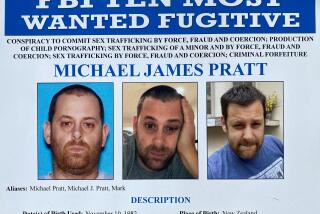Former Black Panther’s Lawyers Wrap Up Case
SANTA ANA — Wrapping up their case to have Elmer “Geronimo” Pratt’s murder conviction overturned, lawyers for the imprisoned former Black Panther Party leader Tuesday said they had demonstrated that the key prosecution witness against Pratt had a “classic” informant relationship with police.
Showing that former Los Angeles County sheriff’s deputy and ex-Panther Julius C. “Julio” Butler was a police informant is crucial to Pratt’s effort to win a new trial on the murder charge that sent him to prison in 1972.
As Pratt’s hearing enters its final days, with prosecutors presenting their case, Pratt’s legal team has suffered two blows. Attorney Johnnie L. Cochran Jr. has gone to New York to prepare for the launch of his new show on Court TV and will not return until final arguments. In addition, San Francisco attorney Stuart Hanlon’s wife Kathy was diagnosed last week with leukemia.
She will be hospitalized at least for a month, said Hanlon, 48, who became involved in the Pratt’s case when he was a 24-year-old law school student. As serious as his wife’s illness is, Hanlon said, she told him to return to Southern California and complete this hearing on a case he has been involved in nearly all of his adult life.
Key evidence against Pratt came from Butler when he testified nearly 25 years ago that Pratt confessed to him that he had shot schoolteacher Caroline Olsen to death and critically wounded her husband during a 1968 robbery that netted $18 on a Santa Monica tennis court.
Pratt, 49, has contended that he was in the Bay Area when the murder was committed, and that FBI agents knew it because they had him under surveillance.
Butler implicated Pratt in the Olsen murder as part of an FBI effort to “neutralize” Pratt, then head of the Panthers in Los Angeles, Pratt’s lawyers say.
Butler, 64, now a lawyer and chairman of the board at Los Angeles First African Methodist Episcopal Church, testified that he had never been an informant for law enforcement. But FBI documents released seven years after Pratt’s conviction show that he had been providing information to agents for more than two years before Pratt’s trial.
Hanlon said outside court Tuesday that testimony over 13 days has produced different, but better, evidence than initially expected.
He said that evidence is focused on August 1969, when Butler gave a letter implicating Pratt in the Olsen murder to Los Angeles Police Sgt. Duwayne Rice. At that time, Hanson said, Butler was under investigation by the FBI for possessing a Thompson submachine gun.
Two retired Los Angeles police officers, Capt. Edward Henry and Rice, testified that in August 1969 Butler led them to a vacant lot in either Pasadena or Altadena where they recovered a cache of alleged Panther weapons, including a Thompson submachine gun--just days after Butler gave Rice the letter incriminating Pratt.
At the time, Butler, Pratt and five other Panthers were also charged with abducting and beating Ollie Taylor, a 17-year-old Panther they suspected of being an infiltrator from a rival group.
Without consulting his attorney, Butler pleaded guilty to four felonies in the Taylor case. One of Butler’s previous attorneys testified in Santa Ana that he felt Butler had no fear of receiving serious punishment after pleading guilty.
Butler was sentenced to probation and a $200 fine, an extraordinarily light punishment for four felonies, Pratt’s lawyers say. That sentence was justified, in part, by a favorable probation report that included a statement from Sgt. Rice that Butler “has been cooperative” with Los Angeles police.
“The one thing we never saw coming into this hearing was this focal point of Butler being an informant for Rice and Henry,” Hanlon said.
Butler’s relationship with Rice and Henry “is your classic informant relationship with law enforcement,” Hanlon said.
Butler acknowledged during his testimony that he had provided information to FBI agents and Los Angeles police but insisted that he has never been an informant.
Prosecutors called their first witness Tuesday and are expected to call about seven more.
More to Read
Sign up for Essential California
The most important California stories and recommendations in your inbox every morning.
You may occasionally receive promotional content from the Los Angeles Times.










